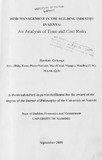| dc.description.abstract | Three major risks are involved in a building project during the construction period: the likelihood of cost overrun, likelihood of time overrun and the likelihood of poor quality workmanship. Formal and empirical risk management techniques have been used at least during the last decade, to identify, measure and respond to risks (Flanagan & Norman
1993).
However, the methodology of risk management in building projects in Kenya is still rather informal and intuitive in nature. It is normally based on the skill and past experience of the ‘risk manager’. This approach to risk management is unlikely to give adequate identification and measurement of risks and response to them. Consequently, cost and time overruns have been observed to be the norm rather than the exception in the Kenyan building industry (Mbatha 1986, Talukhaba 1989).
This study aims at investigating time and cost risks in building projects in Kenya. It examines the factors that expose building projects to the risks of cost overruns, time overruns and poor quality workmanship, and assesses the adequacy of the risk management criteria used in the country’s building industry. In addition, the study also develops a mathematical model for predicting the expected cost and time overruns in proposed building projects.
The target population in the study comprises all the professionally designed and managed building projects executed in Nairobi between 1990 and 1999. A sample of 37 projects has been studied. The data was collected from the architects, quantity surveyors and contractors involved in the projects, using questionnaires and has been analysed using frequencies, descriptive statistics (mean, mode, median etc), correlation and regression analyses.
The study observes that the Conditions of Contract used in the mainstream building industry are a major risk factor in the building project. This factor occurs as early as the inception stage of the project and influences all the other stages.
The most serious source of cost and time risks in building projects during the construction period is ‘extra work’ (technically termed as variations), which normally occurs in 73.50% of the building projects in the population from which the data was obtained. ‘Defective materials’ is the major cause of poor quality workmanship and occurs in 38.20% of the projects. The more frequent a risk factor is the greater is its severity (seriuosness of adverse impact) on the project cost, time or quality. Severity has been measured on a 5-point horizontal numeric scale, with 1 representing not severe at all and 5 representing extremely severe.
The standard of risk identification, measurement and response in the Kenyan building industry has been observed to be relatively low. The levels of adequacy of risk identification, measurement and response are 68.1%, 27.6% and 63.5% respectively. The levels of adequacy have been measured by investigating the amount of information available to the project team and the specific precautions taken by the team to identify, measure and respond to the risks during the inception, design and construction stages of the project. The method of measuring the magnitude of risks is the most inarticulate aspect of the risk management approach in Kenya. Using this risk management approach, the mean probability of a cost overrun or a time overrun in a proposed building project is quite high.
Multiple regression analysis produced four mathematical models for predicting: -
♦ Cost risk - the likelihood of a cost overrun occurring in a proposed project;
♦ Time risk - the likelihood of a time overrun occurring in a proposed project;
♦ Cost overrun - the magnitude of the expected cost overrun (millions of Kshs);
♦ Time overrun - the magnitude of the expected time overrun (weeks).
The models are formulated as follows: -
(i) Cost Risk (CR)
CR = e'1 / (1 + en)
x] = 6.485 + 0.015CE - 10.0921 + 1.285TP1 - 1.111CL - 1.020 TD1
(R2 = 0.7544)
(ii) Time Risk (TR)
TR = e'/(l + ex)
X= 7.120 + 0.017CE - 9.958 I + 1.372 TP1 + 3.093 T4 - 1.643 CL - 1.377 TDI
(R2 = 0.6198)
(iii) Cost Overrun (CO)
CO = 10.946 CR + 0.166 CE (R2 = 0.7544)
(iv) Time Overrun (TO)
TO = 5.2176 + 45.3838TR (R2 = 0.6052)
Where: CR - probability that cost overrun will occur TR - probability that time overrun will occur CE - contact sum in millions of Kshs
I - adequacy of risk identification [(measured as a proportion, in the interval (0 1)]
TP1 - type of building (residential =1. other =0)
TP4 - type of building (industrials, other =0)
CL - type of client (private = 1, public =0)
TDI - method of tendering (selective — 1, other = 0) e = 2.7183
CO - cost overrun in millions of Kshs
TO - time overrun in weeks
R2 - Square of the Multiple correlation coefficient.
In the models, the independent variables explain 75.44%, 61.98%, 75.44% and 60.52% of the variability in cost risks, time risks, cost overruns and time overruns respectively.
The study recommends that the Conditions of Contract be revised. It also recommends that the prediction models developed in the study be refined (by incorporating more independent variables and applying better scales of measuring the variables in order to increase the R' values), tested and then used in the Kenyan building industry - together with the other formal risk management techniques existing in the risk management theory- to manage the risks that occur in building projects during the construction period | |

